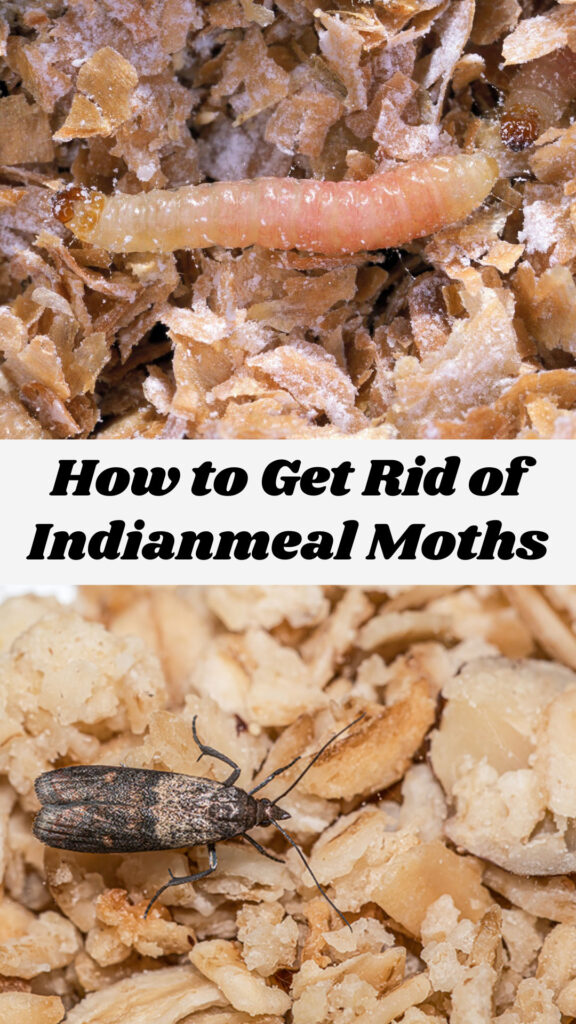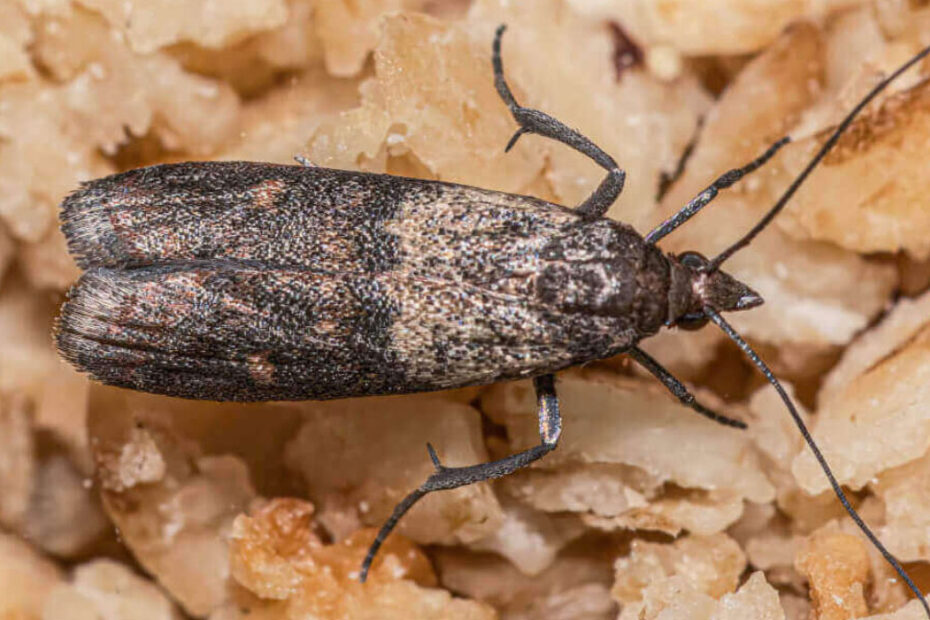Indianmeal moths can turn your pantry into a nightmare, infesting everything from grains to pet food. These pesky invaders are not only unsightly but can also contaminate your food, leading to waste and frustration. If you’ve spotted these small, grayish moths fluttering around or found their larvae in your food, it’s time to take action.
Getting rid of Indianmeal moths involves more than just swatting a few away. You need a comprehensive approach to ensure they don’t return. From identifying the source to cleaning and preventing future infestations, we’ll guide you through the steps to reclaim your kitchen and keep it moth-free.
Key Takeaways
- Identify Indianmeal Moths: Recognize their appearance, lifecycle, and diet to pinpoint infestations quickly.
- Signs of Infestation: Look for visible moths, larvae, webbing, damaged foods, and pupal casings to detect an infestation early.
- Prevent Future Infestations: Use airtight containers, freeze susceptible items, and implement regular cleaning to deter moths.
- Effective Removal Methods: Combine natural remedies, chemical solutions, and traps to thoroughly eliminate Indianmeal moths.
- Deep Cleaning and Prevention: Post-infestation, deep clean your pantry and utilize long-term prevention tips like regular inspections and natural repellents.

Understanding Indianmeal Moths
When dealing with pantry pests, Indianmeal moths can be particularly troublesome. It’s essential to understand their characteristics and how to identify signs of infestation to manage them effectively.
What Are Indianmeal Moths?
Indianmeal moths are common pantry pests that can damage stored food products. Their scientific name is Plodia interpunctella. Here’s a breakdown of their key characteristics:
- Appearance: Adult moths have a wingspan of about 5/8 inch. Their wings are usually brown with distinctive reddish-brown tips.
- Lifecycle: The lifecycle includes egg, larva (caterpillar), pupa, and adult stages, typically lasting 30-300 days depending on conditions.
- Diet: Larvae mainly feed on grains, nuts, dried fruits, spices, cereals, and pet food.
Signs of Infestation
Identifying an Indianmeal moth problem early can prevent extensive contamination. Here are the common signs:
- Visible Moths: Adult moths are often seen flying near light sources or around the pantry.
- Larvae and Webbing: Look for small, cream-colored caterpillars and silk webbing in food products.
- Damaged Foods: Infested items may have small holes, clumps, or a fine, dusty residue.
- Pupal Casings: You might find pupal cases attached to surfaces, indicating that larvae have pupated into moths.
Recognizing these signs can help you take prompt action to eliminate these pests and protect your food supplies.
Preventing Infestation
Preventing Indianmeal moth infestation is crucial to keeping your pantry moth-free. By following proper storage practices and regular cleaning tips, you can reduce the risk of an infestation.
Proper Storage Practices
Implementing effective storage practices can greatly reduce the chances of infestation:
- Airtight Containers: Store dry goods like cereals, grains, and nuts in airtight containers to prevent moths from accessing the food.
- Freezing: Freeze susceptible items, such as flour and rice, for at least one week before placing them in the pantry.
- Purchased Foods: Inspect all purchased foods for any signs of infestation before storing them. Look for webbing or larvae in packages.
- Use Old Stock First: Apply the FIFO (First In, First Out) method to reduce the risk of older, potentially infested goods contaminating new ones.
- Bay Leaves: Place bay leaves in containers and on pantry shelves as their strong scent deters moths.
Regular Cleaning Tips
Maintaining a clean pantry environment is essential in preventing moths:
- Frequent Inspection: Regularly inspect pantry shelves and storage areas for any signs of larvae, webbing, or adult moths.
- Shelf Cleaning: Wipe down shelves and pantry surfaces with a vinegar solution to remove any potential egg deposits.
- Vacuuming: Use a vacuum to clean cracks and crevices where moths may lay eggs. Immediately dispose of the vacuum bag after use.
- Trash Management: Dispose of any contaminated food items in a sealed bag and remove the trash from your home promptly.
- Repellent Pouches: Store sachets of natural repellents such as lavender or cedarwood in the pantry to deter moths.
Preventing Indianmeal moth infestation involves a combination of proper storage practices and rigorous cleaning routines. By following these steps, you can safeguard your food supplies and keep your pantry moth-free.
Identifying the Infestation
It’s crucial to recognize the signs of an Indianmeal moth infestation promptly. These pests can cause significant damage to your pantry supplies. Knowing where to look and what to look for will help you take swift action.
Common Hiding Spots
Indianmeal moths often hide in dark, undisturbed areas where food is stored. Check these common hiding spots to identify an infestation:
- Pantries and Cabinets: Look in corners and behind containers.
- Food Packages: Inspect inside and around bags of flour, cereals, grains, and spices.
- Cracks and Crevices: Examine cracks in shelves and baseboards.
- Pet Food Storage: Donât forget to check pet food bags and containers.
Tools and Methods for Detection
To effectively identify an infestation, use the following tools and methods:
- Flashlight: Helps you spot larvae and moths in dark areas.
- Sticky Traps: Place pheromone traps to catch adult moths.
- Magnifying Glass: Useful for inspecting small areas and identifying eggs or larvae.
- Food Inspections: Regularly check stored food items for webbing, larvae, or damaged grains.
- Vacuum Cleaner: Remove eggs, larvae, and debris in hard-to-reach areas using a vacuum with a nozzle attachment.
Monitoring these areas and employing these tools will ensure you detect any signs of Indianmeal moths sooner, allowing for prompt action and effective control.
Methods to Get Rid of Indianmeal Moths
Efficiently getting rid of Indianmeal moths involves using natural remedies, chemical solutions, and traps. These methods ensure a comprehensive approach to eliminating these pests from your pantry.
Natural Remedies
Natural remedies offer a safe alternative for those concerned about chemical exposure. Here are some effective natural methods:
Bay Leaves: Placing bay leaves in your pantry deters moths. Position them near food containers and on shelves.
Vinegar: Clean infested areas with a solution of equal parts water and vinegar. This mixture helps remove eggs and larvae.
Essential Oils: Use essential oils like eucalyptus, peppermint, or lavender. Place cotton balls soaked in the oils in your pantry to repel moths.
Freezing: Store susceptible foods (e.g., grains, nuts) in the freezer for at least four days to kill any eggs or larvae.
Chemical Solutions
When natural remedies aren’t enough, chemical solutions can provide more immediate results. These options should be used cautiously to avoid health risks:
Aerosol Insecticides: Use aerosol insecticides labeled for pantry pests. Follow the manufacturer’s instructions, focusing on cracks and crevices.
Dust Insecticides: Apply insecticidal dust in hard-to-reach places. These dusts can penetrate deep into cracks where moths may hide.
Insect Growth Regulators (IGRs): IGRs prevent larvae from maturing into adult moths. Use them as part of an integrated pest management program.
Food-safe Pesticides: Select pesticides specifically labeled as safe for food storage areas to avoid contamination.
Using Traps
Traps help monitor and reduce moth populations. They should be used alongside other control methods for best results:
Pheromone Traps: Pheromone traps attract male moths, interrupting the mating cycle. Place them in various locations around your pantry.
Sticky Traps: Use these traps to catch adult moths. Replace them regularly to maintain effectiveness.
Homemade Traps: Create homemade traps using a mixture of molasses and vinegar. This attracts and traps moths, providing a natural solution.
Using these methods in conjunction strengthens your efforts to eradicate Indianmeal moths and prevents future infestations. Regular inspections and cleanliness remain crucial in maintaining a moth-free pantry.
Post-Infestation Measures
Having eliminated active Indianmeal moths, focus on restoring and safeguarding your pantry. Follow these measures to ensure a lasting moth-free environment.
Deep Cleaning Procedures
Thorough cleaning is crucial after an infestation to remove any remaining eggs or larvae. Here’s a step-by-step guide:
- Empty the Pantry: Remove all items, examining them closely for signs of moths or larvae.
- Discard Infested Food: Dispose of any contaminated food in sealed plastic bags.
- Vacuum Shelves and Corners: Use a vacuum to clean all surfaces, especially corners, cracks, and edges.
- Wipe Down Surfaces: Use a mixture of vinegar and water or hot, soapy water to wipe down shelves, walls, and floors.
- Clean Containers: Wash all storage containers with soapy water to ensure no eggs or larvae remain.
- Inspect and Clean Nearby Areas: Check and clean adjacent areas like cupboards, drawers, and countertops.
Long-Term Prevention Tips
Preventing reinfestation requires consistent effort and smart storage practices:
- Use Airtight Containers: Store all dry goods in airtight containers to prevent moths from accessing food.
- Regular Inspections: Frequently check your pantry for signs of moth activity, such as webbing or larvae.
- Freeze Susceptible Items: Freeze grains, nuts, and flours for at least four days before storage to kill any eggs or larvae.
- Rotate Stock: Apply the FIFO (First In, First Out) method to use older items first and prevent long-term storage.
- Clean Regularly: Schedule regular cleanings of your pantry, wiping down surfaces and vacuuming cracks.
- Natural Repellents: Place bay leaves, lavender sachets, or cedarwood blocks in your pantry to deter moths naturally.
By incorporating these post-infestation measures, you can maintain a clean and moth-free pantry, safeguarding your food supplies effectively.
Conclusion
Taking decisive action against Indianmeal moths is crucial for maintaining a clean and moth-free pantry. By identifying infestations early and implementing thorough cleaning and prevention strategies, you can protect your food supplies effectively. Use airtight containers, inspect food regularly, and employ natural repellents to keep these pests at bay. If necessary, don’t hesitate to use chemical solutions and traps for more stubborn infestations. Consistent vigilance and good storage practices will ensure your kitchen remains a safe and healthy environment, free from the nuisance of Indianmeal moths.
Frequently Asked Questions
What are Indianmeal moths?
Indianmeal moths are small insects that infest pantries, contaminating food supplies. They are identifiable by their distinctive banding on the wings.
How do Indianmeal moths get into my pantry?
Indianmeal moths can enter your pantry through contaminated food products brought from the store. They can also fly in through open doors and windows.
What is the lifecycle of an Indianmeal moth?
The lifecycle of an Indianmeal moth includes egg, larva, pupa, and adult stages, with the entire cycle taking about 4-6 weeks.
What are common signs of an Indianmeal moth infestation?
Signs include visible moths, larvae, webbing in food packages, damaged food, and pupal casings.
How can I prevent Indianmeal moth infestations?
Prevent infestations by storing food in airtight containers, freezing susceptible items before storage, inspecting purchased foods, and using the FIFO method.
What cleaning methods help prevent Indianmeal moths?
Regular cleaning includes wiping down pantry surfaces with vinegar, vacuuming cracks and crevices, and managing trash effectively.
Are there natural repellents for Indianmeal moths?
Yes, natural repellents like bay leaves, lavender, and cedarwood can help deter moths.
How can I detect an Indianmeal moth infestation early?
Use tools like flashlights, sticky traps, and magnifying glasses to inspect food packages and pantry areas regularly.
What natural remedies can I use to get rid of Indianmeal moths?
Natural remedies include using bay leaves, vinegar, essential oils, and freezing infested foods.
What chemical solutions are effective against Indianmeal moths?
Chemical solutions include aerosol insecticides, dust insecticides, insect growth regulators (IGRs), and food-safe pesticides, used with caution.
What kinds of traps work for Indianmeal moths?
Effective traps include pheromone traps to disrupt mating, sticky traps to catch adult moths, and homemade traps using molasses and vinegar.
What should I do post-infestation to safeguard my pantry?
Deep clean the pantry by emptying shelves, discarding infested food, vacuuming surfaces, and wiping down with vinegar or soapy water.
How can I ensure long-term prevention of Indianmeal moths?
Use airtight containers, conduct regular inspections, freeze susceptible items, rotate stock, and use natural repellents to prevent future infestations.
